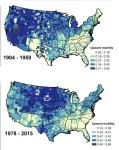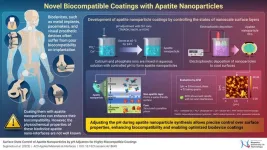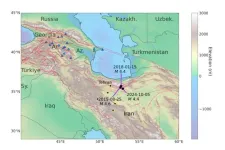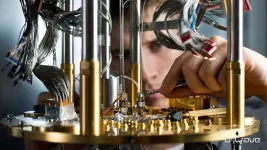(Press-News.org) INDIANAPOLIS -- Addressing patients’ health-related social needs such as housing instability, food insecurity, transportation barriers and financial strain is important to improving health outcomes yet can be challenging. A new study from Regenstrief Institute and Indiana University Indianapolis Richard M. Fairbanks School of Public Health investigates the best approach to predicting likely need for one or more health-related social need services.
To identify emergency department (E.D.) patients needing these services, researchers compared the use of machine learning to pull relevant information from a patient’s electronic health record (EHR) vs. administering patient-completed screening surveys to identify E.D. patients likely to need services to address health-related social needs within the next 30 days. They found that a machine learning predictive model leveraging several robust EHR data sources, including scheduling data and clinical notes, outperformed a screening questionnaire model in predicting future need for health-related social services.
“Access to information is a key prerequisite to effective care and delivery of that care,” said study senior author Joshua Vest, PhD, MPH, a Regenstrief research scientist and professor of health policy and management at the Fairbanks School of Public Health. “The trend in U.S. health care is towards helping address patients’ health-related social needs. To get patients to services effectively starts with finding patients that have needs and want assistance. Screening surveys are common way of accomplishing that goal. However, surveys face a lot of challenges. Most notably, patients and clinicians already have lots of surveys and questionnaires every visit. This study sought to see if using existing data and predictive models performed as well.
“We are hoping to develop tools that we can integrate into EHR systems to make the process of identifying and addressing health-related social needs easier and more effective for everyone.”
While the machine learning model did a better job of predicting future need, both models demonstrated biases. Both models were better at identifying White, non-Hispanic patients with health-related social needs than identifying patients from other races and ethnicities with these needs.
“An emergency department is a great place to screen for health-related social needs because many patients who show up are among the most vulnerable and most likely to fall through the cracks due to lack of comprehensive health insurance, transportation barriers, financial insecurity, or not having a doctor to address their asthma or whatever brought them to the E.D.,” said study first author and health services researcher Olena Mazurenko, M.D., PhD, M.S., a Regenstrief Institute affiliate scientist and an associate professor of health policy and management at the Fairbanks School of Public Health. “E.D. population is very vulnerable and known to have higher health-related social needs compared to the average patient population seen in primary care.
“We know that currently, many of these patients -- individuals with health-related social needs -- are not identified, and many are racial and ethnic minorities or other vulnerable groups. While their clinical needs are being cared for, they often end up returning repeatedly to the E.D. because their social needs haven’t been addressed.”
In addition to benefiting patient care, collecting health-related social needs information is a growing necessity for healthcare providers due to quality reporting requirements from the Centers for Medicare and Medicaid Services (CMS) and other organizations, including The Joint Commission, the largest health care standards-setting and accrediting body in the U.S.
“Comparing the performance of screening surveys versus predictive models in identifying patients in need of health-related social need services in the emergency department” is published in PLOS One.
The Agency for Healthcare Research & Quality funded this study (1R01HS028008 PI: Vest). The Regenstrief Data Core and Eskenazi Health supported this project.
Regenstrief Institute Research Scientist Christopher Harle, PhD, is a study co-author.
All authors and their affiliations as listed in the paper:
Olena Mazurenko1,2, Adam T Hirsh3, Christopher A Harle1,2, Joanna Shen2,4, Cassidy McNamee1, Joshua R Vest1,2
1Department of Health Policy & Management, Indiana University Richard M. Fairbanks School of Public Health-Indianapolis, Indianapolis, Indiana, United States of America.
2Regenstrief Institute, Indianapolis, Indiana, United States of America.
3School of Science, Indiana University-Indianapolis, Indianapolis, Indiana, United States of America.
4Department of Biostatistics, Harvard T.H. Chan School of Public Health, Boston, Massachusetts, United States of America.
Joshua R. Vest, PhD, MPH
In addition to being a research scientist with the Clem McDonald Center for Biomedical Informatics at Regenstrief Institute, Joshua R. Vest, PhD, MPH, is associate dean for research and a professor of health policy and management at the Indiana University Indianapolis Richard M. Fairbanks School of Public Health.
END
Identifying ED patients likely to have health-related social needs
Study explores patient surveys vs. machine learning from EHR data
2025-02-04
ELSE PRESS RELEASES FROM THIS DATE:
Yo-yo dieting may significantly increase kidney disease risk in people with type 1 diabetes
2025-02-04
WASHINGTON—Body-weight cycling (also known as yo-yo dieting) has been shown to significantly increase the risk of kidney disease in people with type 1 diabetes, regardless of body mass index (BMI) and other traditional risk factors, according to a new study published in the Endocrine Society’s Journal of Clinical Endocrinology & Metabolism.
Yo-yo dieting is defined as repeatedly losing and gaining weight multiple times over the years. Its prevalence is reported to be as high as 35% in men and 55% in women.
This patten of dieting has been shown to increase risks of cardiovascular events ...
Big cities fuel inequality
2025-02-04
A study combining remote sensing and administrative data finds that since the mid-20th century, large, growing cities have ceased to be centers of upward social and economic mobility.
Cities have been celebrated as places of innovation and social mobility but also as hotspots of inequality and poverty. Dylan Shane Connor and colleagues measured how the size, density, and connectedness of urban areas in an American’s birth county predicted their social mobility across the 20th century. The results tell a tale of a waning relationship between ...
Financial comfort and prosociality
2025-02-04
People who feel financially comfortable are more likely to report prosocial actions like donating money and prosocial attitudes than people in a tough financial situation, according to a study. Prosociality—preferences and behaviors that benefit others—is essential to human society. In practice, it is determined by both the desire and the ability to help. Paul Vanags and colleagues analyzed data from the Global Preferences Survey and the Gallup World Poll, including 80,337 people in 76 countries with incomes ranging from about $200 a year to about $380,000 per year, adjusted to be equivalent across the different countries ...
Painted lady butterflies migrations and genetics
2025-02-04
A broadly distributed migratory butterfly travels varying distances, influenced by environmental conditions rather than following genetically coded instructions, according to a study. The Afro-Palearctic population of the painted lady butterfly, Vanessa cardui, is a single freely interbreeding, or ‘panmictic’ population.
Vanessa cardui is a renowned world traveler, undertaking multigenerational migrations throughout Africa, Asia, Europe, and North America. The winter breeding range of painted ladies in the Afro-Palearctic includes areas north and south of the Sahara ...
Globetrotting not in the genes
2025-02-04
Painted lady butterflies are world travelers. The ones we encounter in Europe fly from Africa to Sweden, ultimately returning to areas north and south of the Sahara. But what determines whether some butterflies travel long distances while others travel short distances? A group of scientists, including from the Institute of Science and Technology Austria (ISTA), shows that the different migration strategies are shaped by environmental conditions rather than being encoded in the butterfly’s DNA.
It is a warm summer day in June. A group of scientists with sunhats and nets is hiking along a trail in the Catalan mountains. They meticulously search for painted ladies—vibrant orange ...
Patient advocates from NCCN guidelines panels share their ‘united by unique’ stories for world cancer day
2025-02-04
PLYMOUTH MEETING, PA [February 4, 2025] — The National Comprehensive Cancer Network® (NCCN®) is joining people and organizations across the globe to commemorate World Cancer Day today. World Cancer Day is a global initiative to improve awareness and knowledge of cancer risks and actions for better prevention, detection, and treatment. It is led and organized by the Union of International Cancer Control (UICC) every February 4.
World Cancer Day 2025 marks the start of the ‘United by Unique’ campaign to highlight how every experience with cancer is unique, even as people touched by cancer ...
Innovative apatite nanoparticles for advancing the biocompatibility of implanted biodevices
2025-02-04
Medical implants have transformed healthcare, offering innovative solutions with advanced materials and technologies. However, many biomedical devices face challenges like insufficient cell adhesion, leading to inflammatory responses after their implantation in the body. Apatite coatings, particularly hydroxyapatite (HA)—a naturally occurring form of apatite found in bones, have been shown to promote better integration with surrounding tissues. However, the biocompatibility of artificially synthesized apatite nanoparticles often falls short of expectations, primarily due to the nanoparticles’ limited ability to bind effectively with biological tissues.
To overcome ...
Study debunks nuclear test misinformation following 2024 Iran earthquake
2025-02-04
A new study debunks claims that a magnitude 4.5 earthquake in Iran was a covert nuclear weapons test, as widely alleged on social media and some mainstream news outlets in October 2024, a period of heightened geopolitical tensions in the Middle East.
Led by Johns Hopkins University scientists, the study warns about the potential consequences of mishandling and misinterpreting scientific information, particularly during periods of international conflict. The findings appear in the journal Seismica.
“There was a concerted misinformation and disinformation campaign around this event that promoted the idea this was a nuclear test, ...
Quantum machine offers peek into “dance” of cosmic bubbles
2025-02-04
Physicists have performed a groundbreaking simulation they say sheds new light on an elusive phenomenon that could determine the ultimate fate of the Universe.
Pioneering research in quantum field theory around 50 years ago proposed that the universe may be trapped in a false vacuum – meaning it appears stable but in fact could be on the verge of transitioning to an even more stable, true vacuum state. While this process could trigger a catastrophic change in the Universe's structure, experts agree that predicting the timeline ...
How hungry fat cells could someday starve cancer to death
2025-02-04
How Hungry Fat Cells Could Someday Starve Cancer to Death
Scientists transformed energy-storing white fat cells into calorie-burning ‘beige’ fat. Once implanted, they outcompeted tumors for resources, beating back five different types of cancer in lab experiments.
Liposuction and plastic surgery aren’t often mentioned in the same breath as cancer.
But they are the inspiration for a new approach to treating cancer that uses engineered fat cells to deprive tumors of nutrition.
Researchers at UC San Francisco used the gene editing technology CRISPR to turn ordinary white fat cells into “beige” fat cells, which voraciously consume calories to make ...
LAST 30 PRESS RELEASES:
Numbers in our sights affect how we perceive space
SIMJ announces global collaborative book project in commemoration of its 75th anniversary
Air pollution exposure and birth weight
Obstructive sleep apnea risk and mental health conditions among older adults
How talking slows eye movements behind the wheel
The Ceramic Society of Japan’s Oxoate Ceramics Research Association launches new international book project
Heart-brain connection: international study reveals the role of the vagus nerve in keeping the heart young
Researchers identify Rb1 as a predictive biomarker for a new therapeutic strategy in some breast cancers
Survey reveals ethical gaps slowing AI adoption in pediatric surgery
Stimulant ADHD medications work differently than thought
AI overestimates how smart people are, according to HSE economists
HSE researchers create genome-wide map of quadruplexes
Scientists boost cell "powerhouses" to burn more calories
Automatic label checking: The missing step in making reliable medical AI
Low daily alcohol intake linked to 50% heightened mouth cancer risk in India
American Meteorological Society announces Rick Spinrad as 2026 President-Elect
Biomass-based carbon capture spotlighted in newly released global climate webinar recording
Illuminating invisible nano pollutants: advanced bioimaging tracks the full journey of emerging nanoscale contaminants in living systems
How does age affect recovery from spinal cord injury?
Novel AI tool offers prognosis for patients with head and neck cancer
Fathers’ microplastic exposure tied to their children’s metabolic problems
Research validates laboratory model for studying high-grade serous ovarian cancer
SIR 2026 delivers transformative breakthroughs in minimally invasive medicine to improve patient care
Stem Cell Reports most downloaded papers of 2025 highlight the breadth and impact of stem cell research
Oxford-led study estimates NHS spends around 3% of its primary and secondary care budget on the health impacts of heat and cold in England
A researcher’s long quest leads to a smart composite breakthrough
Urban wild bees act as “microbial sensors” of city health.
New study finds where you live affects recovery after a hip fracture
Forecasting the impact of fully automated vehicle adoption on US road traffic injuries
Alcohol-related hospitalizations from 2016 to 2022
[Press-News.org] Identifying ED patients likely to have health-related social needsStudy explores patient surveys vs. machine learning from EHR data






